|
|
|
Antigua market
Saturday, March 25 2006
setting: Hotel Palacio Chico, downtown Antigua, Guatemala
This morning after a modest continental-style brunch of raisin bread, melons, and mediocre coffee out in the beautiful Hotel Palacio Chico courtyard, Gretchen and I walked to the Antigua market. It's busy, sprawling, and chaotic. Some of it exists amid catacombs of narrow aisles between permanent structures, like something you'd see in the Old City of Jerusalem, while other parts are in the outdoors under tarps held up by occasional sticks, none of them long enough to a give a gringo any hope of headroom. Gretchen took the opportunity to snap lots of pictures with my camera. We saw things typical of such markets: huge vats of beans, baskets of live chickens and ducks, every imaginable part of all animals that Guatemalans eat in all their grisly recognizability. If, like most Guatemalans, you get your food this way, you don't have to wonder where it comes from.
We'd actually come with something in mind that we wanted to buy in this market. I'd decided that the computer attaché case that I use to carry all my luggage is awkward and uncomfortable when used to carry things any distance. I wanted to abandon that case in Antigua and buy a real backpack as a replacement. (I'd had a backpack in the summer of 1998, but it was stolen from its hiding behind a bush at the University of Michigan in Ann Arbor.) It took awhile but eventually we found a shop selling camping equipment. Through the wonders of modern bartering, Gretchen managed to get me a price of 150 quetzales, or about $19. It's was a good mid-size backpack, with lots of pockets in a wide variety of sizes. In retrospect, the only thing I wish it had was a detachable asspack so I can get to the little things I often need when I'm on an airplane.
We only toured one of Antigua's many ruins today, an old convent on the north edge of downtown. It featured a spectacular lotus-shaped fountain, supposedly the largest in the Spanish-speaking world. Touring the ruins, it was obvious that some of the ruining (and fixing) had happened fairly recently; rebar, for example, is a relatively modern construction material.
In the afternoon we heard some sort of commotion happening out on the Parque Central, so we went to have a look. A religious procession was passing through. It featured only one or two floats based on something terrible that had happened to either Jesus or his followers. Each of these was held aloft by a gaggle of purple-clad youngsters. Between the floats, bands would limp along to a drum beat and a wailing, somewhat discordant, somewhat minor-key horn-based dirge. In Guatemala, religion is all about suffering, and the greater and more realistic the depiction of the suffering, the happier everyone is. In the midst of all of this, the clouds parted momentarily from the peak of Volcán Agua, revealing an antenna nest on its summit. At about that time we randomly ran into Julie, the least pleasant of our Celas Maya classmates. She told us how she'd caught a pickpocket in the act of pickpocketing her on the chicken bus from Xela, but that she'd scared him away and recovered her wallet from the floor after he'd fled.
Antigua is a much calmer, cleaner place than Xela, and I was actually starting to like Guatemala after a day of resting, touring the convent, and being able to cross the cobble streets (whose rough construction forced cars to drive slowly). But then Gretchen and I went to the north end of town on an unsuccessful hunt for a monastary and we found ourselves on the main road out of town, the one preferred by belching chicken buses. There they was again, the unpleasant diesel fumes and thundering motor noises. North of the convent, Antigua turns more conventionally Guatemalan, with scrawnier street dogs and dodgier neighborhoods. Let's just say that these conditions reminded me of why I wanted to be back in the Catskills and tore through the patina of civility that Gretchen and I had successfully cultivated since arriving in Antigua.
Lacking any other place to put this, I want to write a quick paragraph or three about dental work in Guatemala. In the United States, as we all know, when people get work done on their teeth, the goal is almost always to make the teeth look as if nothing bad ever happened to them. Most people in the United States want their teeth to look flawlessly white and natural, and they're willing to pay big bucks to achieve this. But this is not how people approach dentistry in Guatemala. In Guatemala, if you have enough money to afford a dental procedure, you want to have something to show for your trouble. You're proud of your ability to afford a dentist, and you want strangers to know you've been to one (or two or ten). Consequently, many Guatemalans have mouths that are full of gold. If it's a metal, and it's in a mouth, it's always gold.
A common dental procedure, unknown in the United States, is to have golden picture frames put around each incisor. I saw so many of these little frames that I started wondering if the next step would be the painting of little enamel pictures on the teeth themselves. Such pictures would certainly be religious in nature: depictions of saints or horribly bloodied Jesi on crosses.
Another peculiar dental procedure common in Guatemala is the use of thick golden wires snaked between the teeth, running off toward to back to connect to god-knows-what. Even Guatemalans who go for fairly natural-looking dental work often have such wires winding between their molars, something you see when they open their mouths wide.

Gretchen poses in front of a ruin near our hotel.
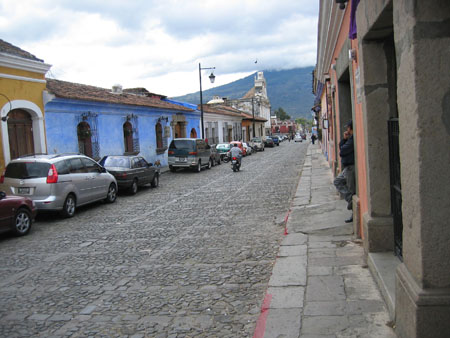

Studies in perspective.

A dog in someone's Antigua driveway.

Most of the feral animals on roofs in Guatemala are cats, but this morning we saw these domestic dogs hanging out on a roof watching the world go by.

In the Antigua market.

Bananas in the Antigua market.

A family in the Antigua market.

In the Antigua market.
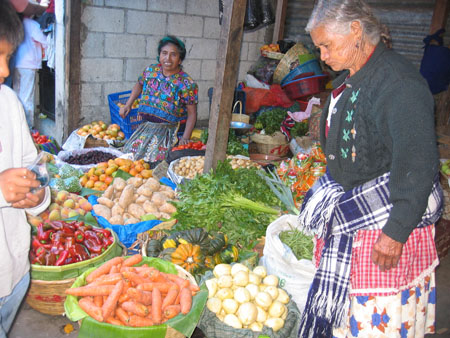
Veggies in the Antigua market.

Fruit in the Antigua market.
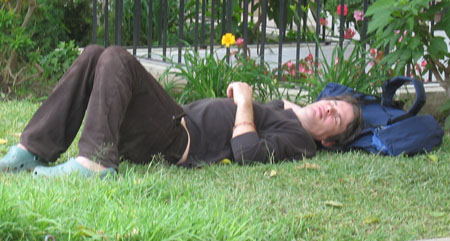
I had a bloody nose this afternoon, so I lay down on the grass near the convent and waited for the bleeding to stop. That's my new backpack.
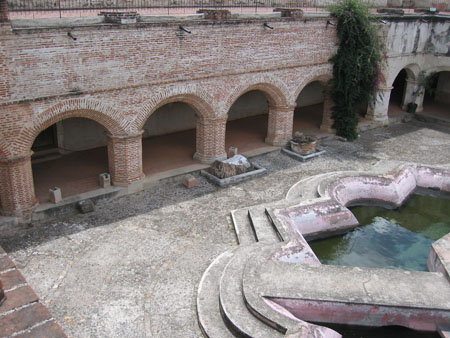
The courtyard of the convent ruins.

One of the biggest fountains in the Spanish-speaking world, in the courtyard of the convent ruins.

Fancy brickwork in the convent.
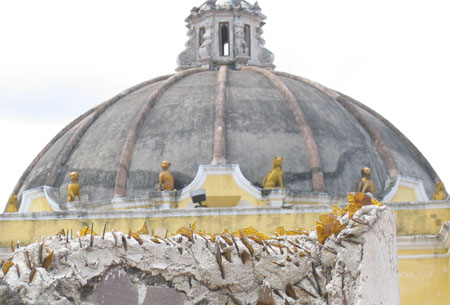
The convent dome, with some modern broken-glass-and-mortar security in the foreground.

A carved door in the convent.
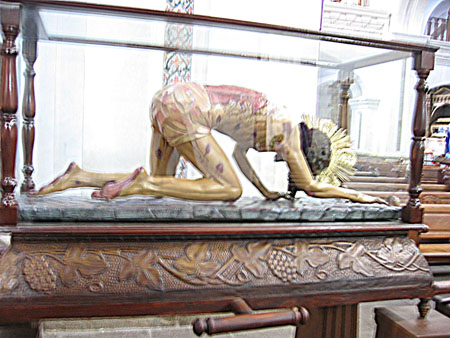
A suffering Christ in a terrarium, a fairly typical three-D depiction of suffering in one of Antigua's main churches.
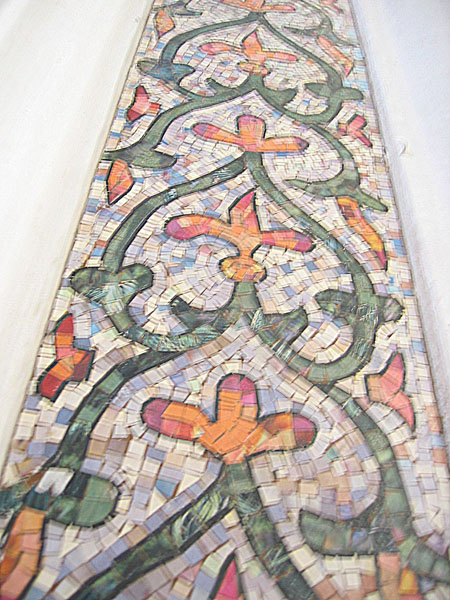
Most of the interior of Antigua's main church was barren of decoration, part of the culture of futility inherent in constructing anything in an earthquake-prone land. But there was this mosaic, made from colorful squares of paper cut from magazines.
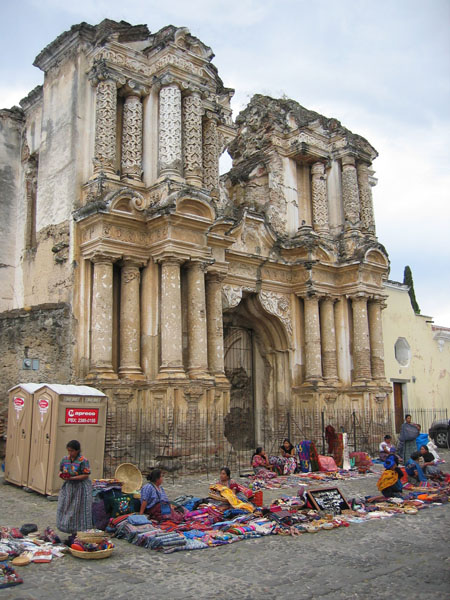
Note how the porta-potties are colored to blend in with the ruins.
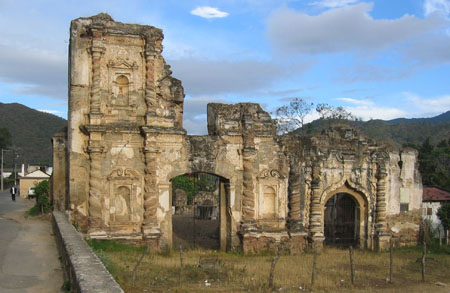
Beautiful Antigua ruins.
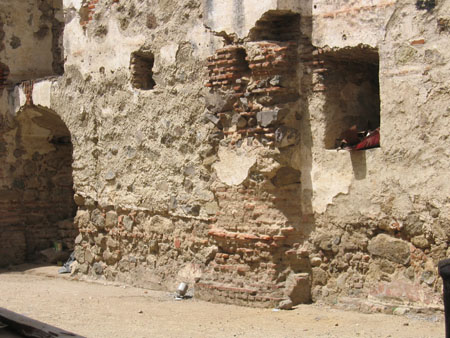
A crumbling wall.
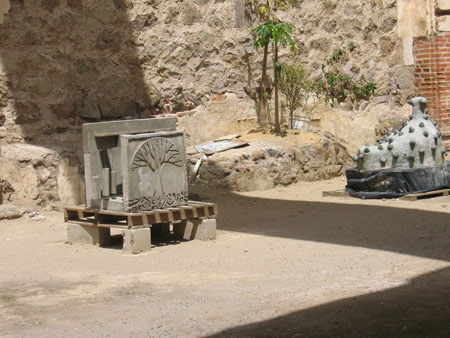
Modern art on display in a ruin.
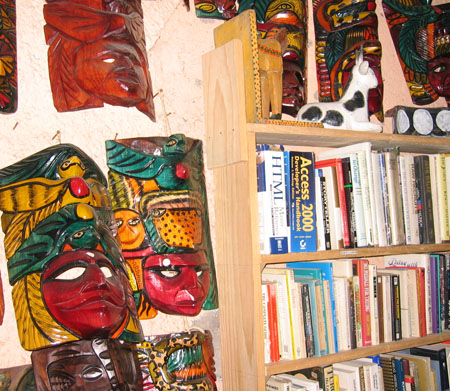
In a store full of cultural artifacts, there was this one bookshelf displaying HTML and MS Access references.
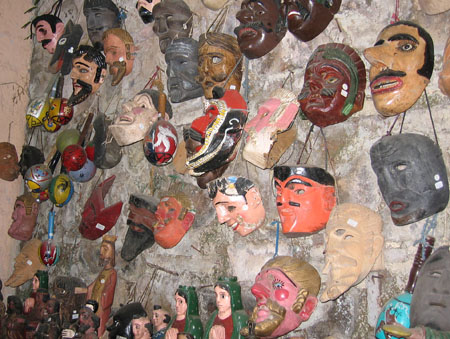
More masks in that store.
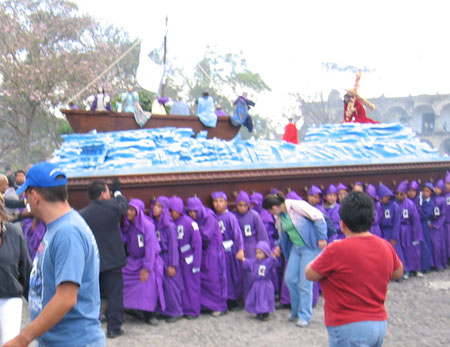
A float called "Ship of Fools" in today's Lent-season procession through Antigua.
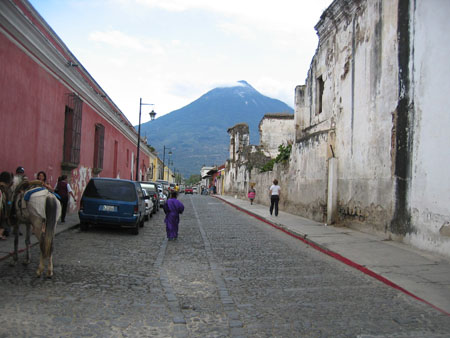
During the procession, Volcán Agua broke through the clouds to the south of Antigua.
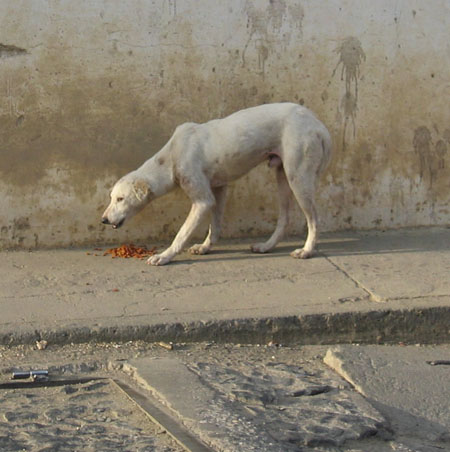
Gretchen bought a bag of cat food for this sad looking street dog. White is not a good color for an animal in this climate; this dog had sunburned ears.
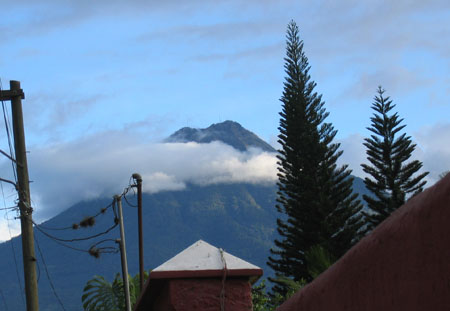
Volcán Acatengo to the southwest of Antigua.
For linking purposes this article's URL is:
http://asecular.com/blog.php?060325 feedback
previous | next |




























